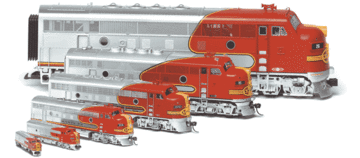Trains
LEGO | Series
LEGO has a long history of producing model trains, beginning with wooden toys made in the 1930s. Motorized LEGO trains have been produced in various forms consistently since 1966 and remain a popular staple of their product line.
The first of the company's plastic brick-built trains was a simple steam locomotive with one passenger carriage released in 1965. The next year LEGO introduced a line of motorized 4.5v battery-powered trains with blue plastic tracks. A 12v system with metal conductor rails in the center of the tracks was added to the line in 1969, produced in parallel with the 4.5v system. Light gray rails with dark gray ties brought more realism in 1980 along with new remote control switch tracks, signals, and other accessories for the 12v system.
Subject ID: 126241
MoreLEGO has a long history of producing model trains, beginning with wooden toys made in the 1930s. Motorized LEGO trains have been produced in various forms consistently since 1966 and remain a popular staple of their product line.
The first of the company's plastic brick-built trains was a simple steam locomotive with one passenger carriage released in 1965. The next year LEGO introduced a line of motorized 4.5v battery-powered trains with blue plastic tracks. A 12v system with metal conductor rails in the center of the tracks was added to the line in 1969, produced in parallel with the 4.5v system. Light gray rails with dark gray ties brought more realism in 1980 along with new remote control switch tracks, signals, and other accessories for the 12v system.
A new 9v system with metal conductor rails replaced both the 4.5v and 12v systems in 1991 and was produced until 2006. LEGO released an adult collector-oriented Santa Fe Super Chief locomotive set in 2002, followed by other advanced and highly detailed sets over the next several years.
The 9v system was discontinued in favor of a simpler battery-powered infrared RC system in 2006. The RC train system was unpopular with enthusiasts and lasted only until 2010 when it was replaced with the more advanced "Power Functions" system of motors and controllers, with Bluetooth connectivity added in 2018.
Through all the different systems, LEGO trains have remained the same scale since the original 4.5v system introduced in 1966. The scale is informally referred to as "L-gauge" among enthusiasts, in reference to traditional model railway scales. LEGO trains use a nominal gauge of 37.5mm, 5.5mm wider than O gauge, derived from a centerline gauge of 40mm (five LEGO studs).
(Final paragraph adapted from Wikipedia, licensed under CC BY-SA 3.0)
Subject ID: 126241
Subject ID: 126241

